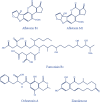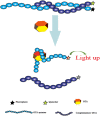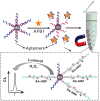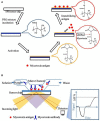Aptamer-Based Biosensor for Detection of Mycotoxins
- PMID: 32373573
- PMCID: PMC7186343
- DOI: 10.3389/fchem.2020.00195
Aptamer-Based Biosensor for Detection of Mycotoxins
Abstract
Mycotoxins are a large type of secondary metabolites produced by fungi that pose a great hazard to and cause toxic reactions in humans and animals. A majority of countries and regulators, such as the European Union, have established a series of requirements for their use, and they have also set maximum tolerance levels. The development of high sensitivity and a specific analytical platform for mycotoxins is much in demand to address new challenges for food safety worldwide. Due to the superiority of simple, rapid, and low-cost characteristics, aptamer-based biosensors have successfully been developed for the detection of various mycotoxins with high sensitivity and selectivity compared with traditional instrumental methods and immunological approaches. In this article, we discuss and analyze the development of aptasensors for mycotoxins determination in food and agricultural products over the last 11 years and cover the literatures from the first report in 2008 until the present time. In addition, challenges and future trends for the selection of aptamers toward various mycotoxins and aptasensors for multi-mycotoxins analyses are summarized. Given the promising development and potential application of aptasensors, future research studies made will witness the great practicality of using aptamer-based biosensors within the field of food safety.
Keywords: aptamer; biosensor; detection; food safety; mycotoxin.
Copyright © 2020 Guo, Wen, Zheng, Saive, Fauconnier and Wang.
Figures











Similar articles
-
Aptasensors for mycotoxins in foods: Recent advances and future trends.Compr Rev Food Sci Food Saf. 2022 Mar;21(2):2032-2073. doi: 10.1111/1541-4337.12858. Epub 2021 Nov 2. Compr Rev Food Sci Food Saf. 2022. PMID: 34729895 Review.
-
Advances in aptamers, and application of mycotoxins detection: A review.Food Res Int. 2023 Aug;170:113022. doi: 10.1016/j.foodres.2023.113022. Epub 2023 May 22. Food Res Int. 2023. PMID: 37316026 Review.
-
Upconversion nanoparticles-modified aptasensors for highly sensitive mycotoxin detection for food quality and safety.Compr Rev Food Sci Food Saf. 2024 May;23(3):e13369. doi: 10.1111/1541-4337.13369. Compr Rev Food Sci Food Saf. 2024. PMID: 38767851 Review.
-
Advances in Aptamer-Based Biosensors for the Detection of Foodborne Mycotoxins.Molecules. 2024 Aug 22;29(16):3974. doi: 10.3390/molecules29163974. Molecules. 2024. PMID: 39203052 Free PMC article. Review.
-
Recent advances in aptasensors for mycotoxin detection: On the surface and in the colloid.Talanta. 2021 Feb 1;223(Pt 1):121729. doi: 10.1016/j.talanta.2020.121729. Epub 2020 Oct 3. Talanta. 2021. PMID: 33303172 Review.
Cited by
-
A Novel and Label-Free Chemiluminescence Detection of Zearalenone Based on a Truncated Aptamer Conjugated with a G-Quadruplex DNAzyme.Biosensors (Basel). 2023 Jan 9;13(1):118. doi: 10.3390/bios13010118. Biosensors (Basel). 2023. PMID: 36671953 Free PMC article.
-
Nanowired dual-electrodes surface to monitor cerebral ischemia by current-volt measurements.3 Biotech. 2021 Dec;11(12):502. doi: 10.1007/s13205-021-03048-4. Epub 2021 Nov 17. 3 Biotech. 2021. PMID: 34881165 Free PMC article.
-
Advances in Nanotechnology-Based Biosensing of Immunoregulatory Cytokines.Biosensors (Basel). 2021 Sep 30;11(10):364. doi: 10.3390/bios11100364. Biosensors (Basel). 2021. PMID: 34677320 Free PMC article. Review.
-
Applications and Tuning Strategies for Transcription Factor-Based Metabolite Biosensors.Biosensors (Basel). 2023 Mar 28;13(4):428. doi: 10.3390/bios13040428. Biosensors (Basel). 2023. PMID: 37185503 Free PMC article. Review.
-
Immunoaffinity Extraction and Alternative Approaches for the Analysis of Toxins in Environmental, Food or Biological Matrices.Toxins (Basel). 2020 Dec 13;12(12):795. doi: 10.3390/toxins12120795. Toxins (Basel). 2020. PMID: 33322240 Free PMC article. Review.
References
-
- Abia W. A., Warth B., Sulyok M., Krska R., Tchana A. N., Njobeh P. B., et al. (2013). Determination of multi-mycotoxin occurrence in cereals, nuts and their products in Cameroon by liquid chromatography tandem mass spectrometry (LC-MS/MS). Food Control. 31, 438–453. 10.1016/j.foodcont.2012.10.006 - DOI
-
- Anfossi L., Di Nardo F., Giovannoli C., Passini C., Baggiani C. (2015). Enzyme immunoassay for monitoring aflatoxins in eggs. Food Control. 57, 115–121. 10.1016/j.foodcont.2015.04.013 - DOI
-
- Bacher G., Pal S., Kanungo L., Bhand S. (2012). A label-free silver wire based impedimetric immunosensor for detection of aflatoxin M1 in milk. Sensor Actuat B-Chem. 168, 223–230. 10.1016/j.snb.2012.04.012 - DOI
-
- Castillo G., Spinella K., Poturnayová A., Šnejdárková M., Mosiello L., Hianik T. (2015). Detection of aflatoxin B1 by aptamer-based biosensor using PAMAM dendrimers as immobilization platform. Food Control. 52, 9–18. 10.1016/j.foodcont.2014.12.008 - DOI
Publication types
LinkOut - more resources
Full Text Sources
Other Literature Sources

